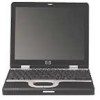HP Nc4010 HP Compaq nx5000 Notebook PC - Maintenance and Service Guide - Page 107
Grounding Equipment and Methods
 |
View all HP Nc4010 manuals
Add to My Manuals
Save this manual to your list of manuals |
Page 107 highlights
Removal and Replacement Preliminaries 4.7 Grounding Equipment and Methods Grounding equipment must include either a wrist strap or a foot strap with a grounded notebook. ■ When seated, wear a wrist strap connected to a grounded system. Wrist straps are flexible straps with a minimum of one megohm ±10% resistance in the ground cords. To provide proper ground, wear a strap snugly against the skin at all times. On grounded mats with banana-plug connectors, connect a wrist strap with alligator clips. ■ When standing, use foot straps and a grounded floor mat. Foot straps (heel, toe, or boot straps) can be used while standing and are compatible with most types of shoes or boots. On conductive floors or dissipative floor mats, use foot straps on both feet with a minimum of one-megohm resistance between the operator and ground. To be effective, the conductive strips must be worn in contact with the skin. Other grounding equipment recommended for use in preventing electrostatic damage includes ■ Antistatic tape. ■ Antistatic smocks, aprons, and sleeve protectors. ■ Conductive bins and other assembly or soldering aids. ■ Nonconductive foam. ■ Static-dissipative tables or floor mats with hard ties to the ground. ■ Field service kits. ■ Static awareness labels. ■ Material-handling packages. ■ Nonconductive plastic bags, tubes, or boxes. ■ Metal tote boxes. ■ Electrostatic voltage levels and protective materials. 4-6 Maintenance and Service Guide















